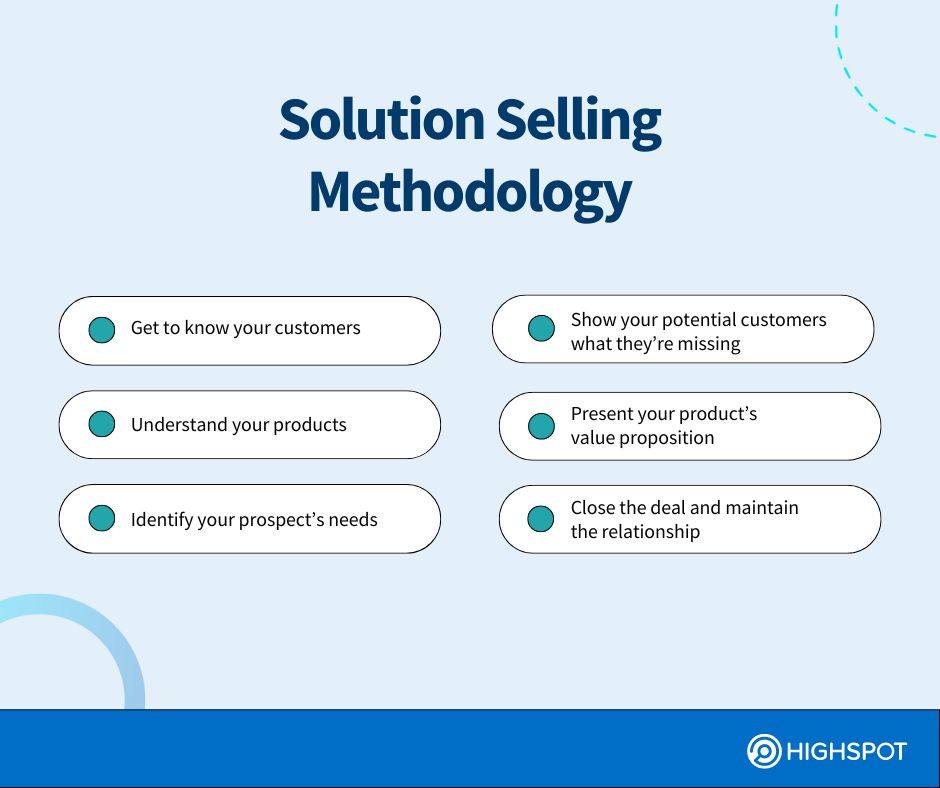A trusted sales advisor isn’t just knowledgeable—they genuinely care about their clients. They prioritise asking questions that matter and work hard to develop meaningful business partnerships. 91% of sellers report they’re more successful when they can solve complex business problems for potential buyers.
B2B buyers and sellers agree that sales teams must move beyond hitting numbers and create personalised, strategic connections. To make this shift, they must move away from reactive, transactional approaches and instead understand customer problems with empathy and determination to solve them.
This guide will explore the depth behind solution selling and how to get started, including practical tips and questions that will help guide your customer-centric relationships.
What Is Solution Selling?
Solution selling is a sales methodology that addresses a customer’s needs and pain points with tailored solutions instead of simply pushing a product to make a sale. Sales reps work closely with potential customers to understand their challenges and recommend the best products or services to overcome them.
When Should You Use Solution Selling?
Solution sales works well in industries with high-value, long sales cycles involving multiple decision-makers. This includes businesses with complex regulatory requirements and fast-changing technology, such as healthcare, finance, manufacturing, and telecommunications. You’ll typically find sales reps in B2B sales using solution sales techniques to dig into what the prospect truly needs and offer a unique package, often involving a combination of products.
The Importance of Solution Selling
Michael Bosworth developed solution-based selling, which became popular in the 1980s and remains highly relevant today. Rather than bombarding prospects with product specs, it shows the real value and ROI they can gain from your offer. Solution sellers take an empathic approach by putting the customer’s best interest first, leading to strong relationships.
The solution selling process also involves getting in-depth knowledge of your prospect. What are they aiming for, and what’s holding them back? What obstacles are they trying to overcome? Whether dealing with outdated processes, poor data management, or fragmented communication, sales reps dive into the heart of these issues to understand how they impact daily operations and goals. By doing so, they can recommend custom solutions that not only address immediate problems but also align with the customer’s long-term vision.
While it does have overlaps with other methodologies, it continues to be a practical sales approach for many high-value deals. However, it’s important to find the sales strategy that works for you, whether it’s product selling for quick sales cycles, value selling for proving impact, solution selling for solving problems, or a combination of methods to boost sales performance.
Solution Selling vs. Product Selling: What’s the Difference?
With product selling, salespeople must persuade you that their product is essential and better than the competition without much regard for your needs. Meanwhile, solution selling flips the script. Sales reps act as consultants, understanding your challenges and mapping out how their solutions can address those to make your life easier. While product features matter, they are not the main focus.
Pros and Cons of Solution Selling
Some might see the extra effort of product knowledge, extensive research, and questioning required by solution selling as a downside. But, investing time in understanding your customers can really pay off. Happy, loyal customers are worth their weight in gold. In fact, 75% of US consumers base buying decisions on customer experience, showing just how important it is to get it right.
| Pros | Cons |
|---|---|
| Builds stronger customer relationships | Longer sales cycles |
| Emphasises value | Time-consuming |
| Reduces objections | Resource-intensive |
Pros:
- Builds stronger customer relationships: When customers see you as someone who genuinely understands and addresses their challenges, they’re more likely to remain loyal and advocate for your solutions within their networks. This also leads to long-term partnerships and repeat purchases, as clients see you as an ally in achieving their goals.
- Emphasises value: When you engage in meaningful conversations and ask probing questions to gather insights into the customer’s challenges and goals, you can craft a tailored pitch highlighting how your recommendation aligns with their unique needs. This creates more perceived value, making customers more willing to invest in your solution over generic alternatives.
- Reduces objections: By understanding customer pain points and providing relevant solutions, sales professionals often reduce objections and are equipped with meaningful responses. For instance, a customer might say, “Your product is too expensive.” When you understand your product and the customer’s unique challenges, you can confidently share and demo the value and ROI of the solution. As a solution seller, you’ll justify the higher price tag by showing how the product reduces operational costs or increases productivity.
Cons:
- Longer sales cycles: Solution selling requires building long-term, trust-based relationships, making it longer to close deals than other methods. That is because you’ll need to identify the customer’s problems, design a bespoke solution, and get approval from multiple decision-makers.
- Time-consuming: Gathering information and tailoring solutions to the potential buyer’s needs requires considerable time and energy, which can impact overall efficiency and productivity.
- Resource-intensive: The need for constant, personalised engagement with each customer can strain your sales team’s capacity, making it difficult to scale the sales process.
How to Get Started With Solution Selling
The solution selling approach requires mastering essential sales skills, from empathy to active listening, to build solid connections and deliver value. It works on a case-to-case basis, so you need to adapt it in your own way as part of your unique strategy. The ultimate goal is to make the customer’s life better.
Let’s look at solution selling fundamentals:

1. Get to know your customers
The best place to start is your company’s buyer personas. From there, you’ll understand the types of organisations and people you’ll frequently deal with, along with the day-to-day struggles they face. While it’s a useful guide, be ready to adapt as you engage with actual clients. Tools like CRM can also provide valuable insights into your customer base.
Besides that, you should track down the people who can give you the green light. You might not connect with the decision-makers right away, so knowing who calls the shots helps you avoid wasting time on someone interested but can’t say yes.
2. Understand your products
Nothing is worse than talking to a sales rep who can only give a canned sales pitch. Before implementing a solution selling strategy, your sales team should know your products inside-out to match benefits to your customer’s needs, including features, pricing, use cases, customisations, and competition. This knowledge will always help you present your product as the right solution.
A comprehensive sales training platform can significantly enhance this understanding by providing structured and interactive learning modules. It can also house all necessary resources, making it easy for sales reps to access the latest product information whenever needed.
Other ways to improve your team’s product knowledge are to provide hands-on experience, attend live or pre-recorded demos, work closely with product and customer service teams, and conduct ongoing coaching. As a sales leader, you should ensure everyone is on the same page about what makes your product valuable and unique, and use consistent language to deliver a unified message to your clients.
Related Resource: The Ultimate Guide to Sales Training
3. Identify your prospect’s needs
Every customer is different, so figure out their potential needs based on your buyer personas and do extra research. Ask broad, open-ended questions during the discovery call to uncover their concerns, preferences, and short- and long-term goals. Active listening is crucial, as it will help you follow up more to gain a deep understanding of their situation and allow you to package a solution to their specific problems.
4. Show your potential customers what they’re missing
While talking with prospective customers, find out what they are currently using and what the existing gaps are. Then, use real-life examples or data to highlight the impact of these gaps on their business.
Help them visualise the benefits they’re missing out on and how addressing these issues with your product or service can lead to better outcomes. For example, if they use basic spreadsheets for project management, show them how your tool’s real-time collaboration and task tracking can save time and improve accountability.
5. Present your product’s value proposition
With a clear understanding of your customer’s needs and the gaps in their current setup, present your product or service as the ideal solution and how it stands out from alternatives. Tailor your pitch to highlight the most relevant aspects of your solution and demonstrate its value in solving their specific problems. This is an excellent opportunity to use case studies to support your claims.
6. Close the deal and maintain the relationship
Once you’ve demonstrated that your product is the best solution, it’s time to close the deal. However, chances are you’ll face objections before closing a sale. After all, your customers need to be convinced that your product or service delivers on its promises. You can prepare yourself for any objections by taking a look at past sales call transcripts to see what worked and what didn’t, and refining your sales pitch with fresh, effective responses. You can also preemptively address common objections during your presentation before the buyer has a chance to raise them so you can stay in control of the conversation.
After they sign the dotted line, continue to nurture the relationship. Follow up to ensure they’re satisfied and address any ongoing needs they might have because customers who rate an experience 5/5 stars are more than twice as likely to buy again, and 80% of satisfied consumers spend more.
Solution Selling Questions
To implement solution selling, ask appropriate questions at each stage of the buying process. Besides consultative selling, you can use SPIN selling techniques to guide the conversation and avoid an overwhelming interrogation. Let’s look at some practical, open-ended questions to help you identify the root cause of the customer’s problem, get buy-in, and gauge the impact.
Identify the cause
Understanding the root of the customer’s pain points is crucial. These questions help you uncover the primary issues they face. For example, during a sales conversation, the customer may describe a situation where their team lost data due to a software glitch. As the sales rep, you can then emphasise your product’s robust data recovery features.
- What challenges are you currently facing with your solution?
- Can you describe a recent problem you encountered?
- What are the primary pain points affecting your team’s productivity?
- How do these issues impact your daily operations?
- What have you tried so far to resolve these challenges?
Get buy-in
Gaining the customer’s buy-in involves understanding their vision and requirements for a solution. These questions facilitate that process. For instance, the customer expresses a high priority for integration. The sales rep can then highlight their product’s compatibility and provide a demo showing out-of-the-box integrations.
- How do you envision an ideal solution addressing your needs?
- Who on your team would benefit the most from this solution?
- What are your main criteria for choosing a new solution?
- How important is it to you to have a solution that integrates with your current systems?
- What are your top priorities when evaluating potential solutions?
Calculate the impact
Can you quantify the impact the pain is having on the customer’s team or business? For example, the customer is losing $5,000 monthly due to outdated tech. Use this opportunity to demonstrate how your solution can significantly reduce these costs.
- How much time do you spend dealing with the current issues?
- What is the estimated cost associated with these challenges?
- How would solving these problems affect your overall productivity?
- What potential revenue gains could be realised by addressing these pain points?
- How do you measure the success of new solutions implemented in your organisation?
Unlock Your Sales Potential with Solution Selling
Solution selling methodology has stood the test of time for a reason. While it may overlap with other approaches, its focus on understanding and solving customer problems makes it incredibly effective for high-value deals. Yes, it requires more time and effort than other methods, but the results can be well worth it. Customers who see the real benefits of your solutions are invaluable. Whether you pair solution selling with other approaches or use it as your primary strategy, deeply understanding and addressing your customers’ needs will always pay off.
Learn how Highspot can coach, train, and guide your sales team to solution sales success. Request a demo today.




